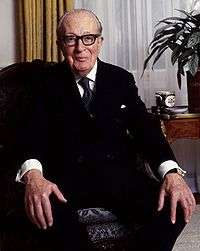Victor Cavendish-Bentinck, 9th Duke of Portland

Victor Frederick William Cavendish-Bentinck, 9th Duke of Portland (18 June 1897[1] – 30 July 1990), known as Victor Cavendish-Bentinck until 1980, was a British diplomat and businessman. He served as Ambassador to Poland between 1945 and 1947.
Background & Education
Cavendish-Bentinck was born in Marylebone, London, second son of Frederick Cavendish-Bentinck, younger son of George Cavendish-Bentinck who was a grandson of William Cavendish-Bentinck, 3rd Duke of Portland. Although formally Victor Cavendish-Bentinck he was known informally as Bill. Like other members of his family he informally dispensed with the name "Cavendish", being known simply as Bill Bentinck.[2] He was educated at Wellington College. In 1980 he succeeded his elder brother Ferdinand William Cavendish-Bentinck, 8th Duke of Portland in the dukedom.
Queen Elizabeth II is also descended from the 3rd Duke of Portland through her maternal grandmother Cecilia Cavendish-Bentinck. The Queen and the 9th Duke of Portland were third cousins, once removed.
Diplomatic career
Cavendish-Bentinck did not pursue a university education, instead entering the diplomatic service in 1919. In 1922, he took charge of administrative arrangements for the Lausanne Conference. He served in the British Embassy in Paris and also in the League of Nations Department in the Foreign Office. Other postings included Athens in 1932 and Santiago in 1933. The high point of his diplomatic career came in 1939 when he was appointed chairman of the Joint Intelligence Committee. He managed to develop the body as a highly effective instrument of government and, as a result, became counsellor to the Services Liaison Department of the Foreign Office in 1942.
In 1945, Cavendish-Bentinck was given his final diplomatic posting on his appointment as Ambassador to Poland. When visiting the formerly German City of Stettin (Szczecin) in 1946 he was invited to talk to German civilians suffering from months of internment so their possessions and property could be taken over by Polish resettlers from territories lost to the USSR. Cavendish-Bentinck refused to do so, ignoring certain inhuman circumstances under which mainly old people, women and children had to suffer, by noticing to his Polish hosts, he was "convinced that they will complain as usual".[3]
He held the position for two years before the Foreign Office applied to appoint him Ambassador to Brazil. He never took up the latter post, being obliged to resign from the Foreign Office as a result of the publicity surrounding his divorce.
After his withdrawal from the diplomatic service, Cavendish-Bentinck embarked on a business career, becoming Vice-Chairman of the Committee of Industrial Interests in Germany. From this position, he was able to advance the interests of British companies such as Unilever. He was a member of the Steering Committee of the Bilderberg Group.[4]
Marriages & Children
Portland[5] married Clothilde Bruce Quigley (died 1984) on 16 February 1924. She was the daughter of James Bruce Quigley. They had two children together:
- William James Cavendish-Bentinck (6 July 1925 - 4 September 1966)
- Lady Mary Jane Cavendish-Bentinck (16 December 1929 - 1 March 2010)
The marriage ended in divorce in 1948. Portland married secondly, Kathleen Elsie Barry (died 2004) on 27 July 1948. She was the daughter of Arthur Barry. This marriage produced one further child:
- Lady Barbara Cavendish-Bentinck
When the 9th Duke of Portland died in 1990, he was interred at the traditional burial place of the Dukes of Portland in the churchyard of St Winifred's Church at Holbeck.
Upon the 9th Duke's death, the dukedom and the Marquessate of Titchfield became extinct because his only son had predeceased him and there were no other surviving male heirs of the 1st Duke. However, the earldom of Portland had been created in an earlier generation than the dukedom and there were surviving descendants in the male line to inherit it. That title was therefore inherited by his kinsman, Henry Noel Bentinck, who became 11th Earl of Portland, together with its subsidiary titles of Viscount Woodstock and Baron Cirencester.
Ancestry
| Ancestors of Victor Cavendish-Bentinck, 9th Duke of Portland | ||||||||||||||||||||||||||||||||||||||||||||||||||||||||||||||||||||||||||||||||||||||||||||||||||||||||||||||||||||||||||||||||||||||||||||||||||||||||||||||||||||||||||||||||||||||||||||||||||||||||||||||||||||||||||||||||||||||||||||||||||||||||||||||||||||||||||||||||||||||||||||||||||||||||||||||||||||||||||||||||||||||||||||||||||||||||||||||||||||||||||||||||||||||||||||||||||||||||||||||||||||||||||||||||||||||||||||||||||||||||||||||||||||||||||||||||||||||||||||||||||||||||||||||||||||||||||||||||||
|---|---|---|---|---|---|---|---|---|---|---|---|---|---|---|---|---|---|---|---|---|---|---|---|---|---|---|---|---|---|---|---|---|---|---|---|---|---|---|---|---|---|---|---|---|---|---|---|---|---|---|---|---|---|---|---|---|---|---|---|---|---|---|---|---|---|---|---|---|---|---|---|---|---|---|---|---|---|---|---|---|---|---|---|---|---|---|---|---|---|---|---|---|---|---|---|---|---|---|---|---|---|---|---|---|---|---|---|---|---|---|---|---|---|---|---|---|---|---|---|---|---|---|---|---|---|---|---|---|---|---|---|---|---|---|---|---|---|---|---|---|---|---|---|---|---|---|---|---|---|---|---|---|---|---|---|---|---|---|---|---|---|---|---|---|---|---|---|---|---|---|---|---|---|---|---|---|---|---|---|---|---|---|---|---|---|---|---|---|---|---|---|---|---|---|---|---|---|---|---|---|---|---|---|---|---|---|---|---|---|---|---|---|---|---|---|---|---|---|---|---|---|---|---|---|---|---|---|---|---|---|---|---|---|---|---|---|---|---|---|---|---|---|---|---|---|---|---|---|---|---|---|---|---|---|---|---|---|---|---|---|---|---|---|---|---|---|---|---|---|---|---|---|---|---|---|---|---|---|---|---|---|---|---|---|---|---|---|---|---|---|---|---|---|---|---|---|---|---|---|---|---|---|---|---|---|---|---|---|---|---|---|---|---|---|---|---|---|---|---|---|---|---|---|---|---|---|---|---|---|---|---|---|---|---|---|---|---|---|---|---|---|---|---|---|---|---|---|---|---|---|---|---|---|---|---|---|---|---|---|---|---|---|---|---|---|---|---|---|---|---|---|---|---|---|---|---|---|---|---|---|---|---|---|---|---|---|---|---|---|---|---|---|---|---|---|---|---|---|---|---|---|---|---|---|---|---|---|---|---|---|---|---|---|---|---|---|---|---|---|---|---|---|---|---|---|---|---|---|---|---|---|---|---|---|---|---|---|---|---|---|---|---|---|---|---|---|---|---|---|---|---|---|---|---|---|---|---|---|---|---|---|---|---|---|---|---|---|---|---|---|---|---|---|---|---|---|---|---|---|---|---|---|---|---|---|---|---|---|---|---|---|---|---|---|---|---|---|---|---|---|---|---|---|---|---|---|---|---|---|---|---|---|---|---|
| ||||||||||||||||||||||||||||||||||||||||||||||||||||||||||||||||||||||||||||||||||||||||||||||||||||||||||||||||||||||||||||||||||||||||||||||||||||||||||||||||||||||||||||||||||||||||||||||||||||||||||||||||||||||||||||||||||||||||||||||||||||||||||||||||||||||||||||||||||||||||||||||||||||||||||||||||||||||||||||||||||||||||||||||||||||||||||||||||||||||||||||||||||||||||||||||||||||||||||||||||||||||||||||||||||||||||||||||||||||||||||||||||||||||||||||||||||||||||||||||||||||||||||||||||||||||||||||||||||
Arms
 |
|
References
- ↑ Births in the Marylebone district of London Registered in July, August and September 1897 vol. 1a p. 541 — General Register Office
- ↑ Patrick Howarth Intelligence Chief Extraordinary, First Edition, p. 13-14
- ↑ Memorandum H. Krajewski, Staatliches Repatriierungsamt (im Folgenden: PUR), Szczecin, 29.10.1946, MZO 196/541b, AAN. 103p} (in German)
- ↑ "Former Steering Committee Members". bilderbergmeetings.org. Bilderberg Group. Retrieved 2014-02-08.
- ↑ The Peerage, entry for 9th Duke of Portland
External links
- Hansard 1803–2005: contributions in Parliament by the Duke of Portland
- http://thepeerage.com/p963.htm#i9622
| Diplomatic posts | ||
|---|---|---|
| Preceded by Sir Owen O'Malley |
Ambassador to Poland 1945–1946 |
Succeeded by Donald Gainer |
| Peerage of Great Britain | ||
| Preceded by Ferdinand Cavendish-Bentinck |
Duke of Portland 1980–1990 |
Extinct |
| Peerage of England | ||
| Preceded by Ferdinand Cavendish-Bentinck |
Earl of Portland 2nd creation 1980–1990 |
Succeeded by Henry Bentinck |